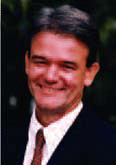TORONTO-Although functional endoscopic sinus surgery (FESS) is a commonly used and well-established tool for the treatment of chronic rhinosinusitis, between 10% and 20% of patients will have recurrent disease and require further surgery. But there are some common problems that can often be avoided by using appropriate imaging and taking the time to understand the anatomy in each case.
This was the key message from ENT surgeons on a panel at the annual AAO-HNS conference who provided tips on how to improve outcomes in FESS. Panel members discussed cases and addressed common difficulties seen in revision surgery, along with tactics to help reduce potential problems.
When it comes to the nuts and bolts of successful FESS, key points include being able to see what you’re doing, having appropriate medical and anesthetic strategies for your surgery, working in such as way as to have minimal blood loss, and making sure the patient is stable, said James Palmer, MD, Assistant Professor of Rhinology at the University of Pennsylvania.
Preoperative Strategies
Tips for preoperative preparation include use of short-term oral corticosteroids to help stabilize the mucosa and decrease blood loss. Oral antibiotics can help decrease inflammation.
Blood loss should be considered ahead of time -what is the total amount of loss that’s acceptable and should the surgery be staged? Consider too the use of pledgets and whether injections are intranasal or intraoral.
For cases with chronic rhinosinusitis, there are six main categories for the approach to antibiotic use: no prior surgeries, perioperative use, antibiotics that are used immediately post surgery, cases where remote surgery is performed (such as for acute exacerbations), inflammatory basis for disease (presence of polyps), and infectious-based cases, Dr. Palmer said.
Peter J. Wormald, MD, Professor of Otolaryngology at the University of Adelaide in Australia, discussed why 3D imaging is highly useful for planning for surgery.
I’ll look at a series of scans, do a 3D reconstruction, identify the drainage pathways and develop a surgical plan….We essentially do a simulated surgery, then see if it works on the patient, he said. Plus, the scans can always be referred back to during surgery.
The Importance of Imaging
Imaging is vital for various types of sinus surgeries, whether it’s frontal, maxillary, or ethmoid.
Dr. Wormald described treatment planning for the case of a 27-year-old male patient who had failed medical treatment and still had significant frontal pain and pressure, along with nasal obstruction and rhinorrhea on the right side. This was a frontal sinus surgery case.
You look at the anatomy, and predict from the CT scan what the anatomy is going to be like-see where the difficult and tricky spots are going to be, Dr. Wormald said. Work out the frontal sinus drainage pathway, have a plan for tackling each cell, and work out the alternatives before starting surgery.
Rodney Schlosser, MD, Associate Professor of Otolaryngology at the Medical University of South Carolina, added that he would also go back and look at the sagittal plane to determine if the cell is diseased or not.
The key point with frontal sinus surgery cases is that the otolaryngologist needs to understand the anatomy in three dimensions so one can complete a frontal recess dissection, Dr. Palmer said.
Some pitfalls can be revealed by 3D CT imaging, such as ISSC narrowing of the ostium and a large bulla frontalis cell obstructing the ostium-as was the case in one example presented. A 3D rendering of the anatomy helps with the surgical plan.
However, one should have a number of alternatives up your sleeve if things don’t go according to plan, Dr. Wormald said.
When it comes to the maxillary sinus, it takes a 70-degree scope to see the Haller cell, which drains the maxillary sinus, Dr. Palmer said. The scope reveals far more than a 30-degree scope can, and helps show how much disease is present in the front cells. Infection is a potential problem in the maxillary sinus if there is recirculated mucus.
Furthermore, it’s important to know exactly where the anterior ethmoid artery is, he said. Injury of the artery can lead to a significant swelling and discoloration around the eye.
Panelists discussed a case presented by Dr. Schlosser of a 22-year-old female who had unilateral cheek pressure for three months, but had failed multiple courses of antibiotics, and had a CT reading of S-P maxillary antrostomy with mucosal thickening.
Dr. Wormald described the case as potentially dangerous if it doesn’t appear regular on a CT scan, and one where a lot of trouble can happen. When it comes to surgery, the technique here is very important, he said
The patient was successfully treated endoscopically with Caldwell-Luc, a ball-tipped probe using a retrograde technique, and a mucocele was drilled out. However, where possible, it’s a good idea to preserve mucosal tissue.
Preoperative reviews of CT scans should include looking for potential CSF leaks, potential orbital injuries (such as lamina papyracea dehiscence and anterior ethmoid neurovascular bundles), and sphenoid complications. The pathology should be reviewed too, Dr. Schlosser said.
In general, with the maxillary sinus, the natural ostium must be included in the antrostomy to prevent recirculation, Dr. Palmer said. Consider a ‘mega-ostium’ or endoscopic medial maxillectomy in cases of recurrent maxillary sinusitis, he said.
Ethmoid Issues
Finally, panelists discussed issues related to the ethmoid sinus.
Dr. Palmer pointed out that with posterior ethmoid entry, watch where the perforation is done and avoid CSF leaks. Enter the basal lamina inferiorally and medially-the site acts as a fulcrum to direct the angle of the endoscope, he said.
CSF leaks can occur via surgical trauma in the posterior ethmoid roof or the lateral lamella of the cribriform plate. Leaks can be dramatic if caused by the powered instruments that are used to ‘skeletonize’ the skull base.
The key to safe surgery in the posterior ethmoid and sphenoid is to always know where the superior turbinate is-as there are not many landmarks in this region for endoscopic navigation. Also, be careful when entering the sphenoid.
You need to identify the variations on the preoperative CT, he said. At the same time, Dr. Palmer cautioned doctors to not blindly trust image-guided devices.
A key tip when it comes to the ethmoid sinus is to do complete removal of the bony septa in the ethmoid cavity, since this will help prevent recurrence in a complete ethmoidectomy, said Dr. Palmer. Paying special attention to the anatomy of the ethmoid roof and the lamina papyracea will help prevent complications.
©2007 The Triological Society


Leave a Reply